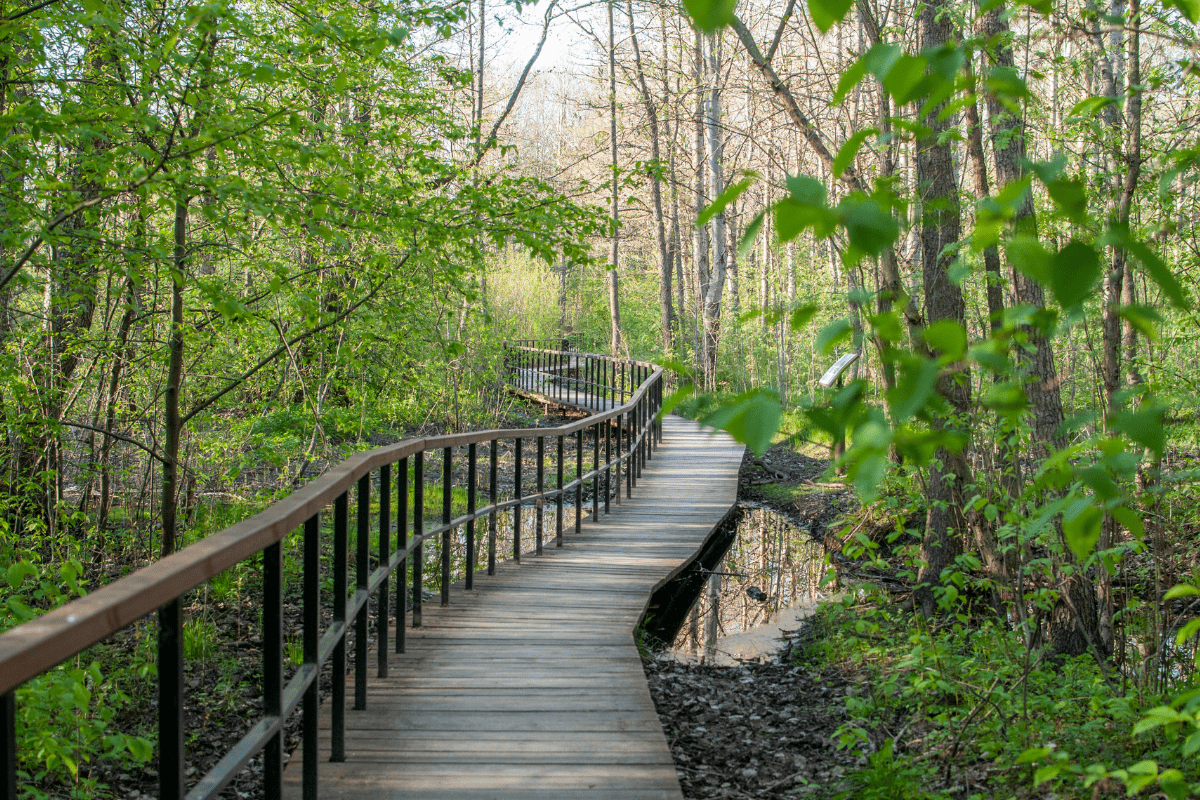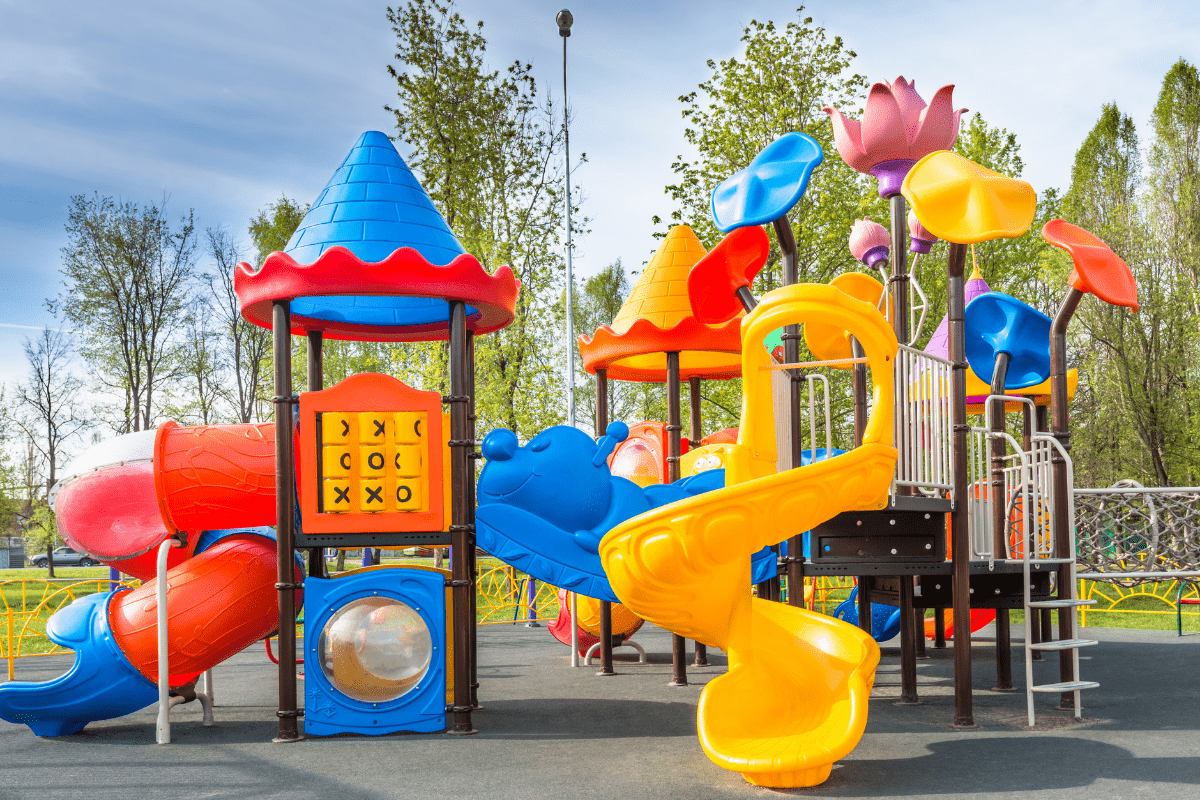Whether you crave sweeping river views, wildflower meadows, or rocky overlooks, the hiking trails around Spokane are ready to deliver. From family-friendly loops to more challenging climbs tucked into local parks, there’s a route here for every pace and season.
Let’s get to it.
Suspension Bridge
At Riverside State Park, the Suspension Bridge sits on a 2.1-mile loop around the Bowl & Pitcher. The trail gains only 134 feet in elevation, making it accessible to walkers, runners, and families alike.
The bridge crosses the Spokane River amid swirling rapids and towering basalt formations that capture most photographs. Trail surfaces include packed dirt and short paved stretches. You will encounter a mix of hikers, cyclists, stroller-pushers, and children who pause when the bridge sways underfoot.
Facilities near the trailhead include a large parking lot, restrooms, and showers by the nearby campground. Picnic tables and covered shelters make it easy to rest or enjoy a meal after a hike. Well-behaved dogs can join on a leash.
Parking requires a Discover Pass, so plan ahead. The trail stays in good condition except after heavy rain when sections can become muddy. To avoid crowds, aim for early mornings or late afternoons on weekends.
Little Spokane River Natural Area
Located north of Spokane, Little Spokane River Natural Area features multiple trails along the Little Spokane River corridor. Knothead Loop challenges hikers with 1,000 feet of elevation gain, rocky sections, and former road grades. It connects to side paths and ends at overlooks and Indian Painted Rock pictographs with interpretive panels.
For a gentler route, the Little Spokane River Trail offers a flat out-and-back path beside the river. In spring, marsh irises bloom in low-lying areas. Saint George’s Trail sits between these levels of difficulty. It sweeps across moderate ups and downs, weaves through forest stands, and provides scattered river views.
The short Painted Rocks Loop takes under an hour. It circles back to the pictographs and stays away from most crowds during weekdays. Amenities are limited. No restrooms or water fountains exist on site, and neither dogs nor mountain bikes are allowed. Trailheads provide informal parking and basic wayfinding signs. Benches sit at select viewpoints for resting or river watching.
John A. Finch Arboretum
Spanning 56 acres, John A. Finch Arboretum offers a mix of manicured and natural trails that follow Garden Springs Creek. The main loop covers 1.25 miles with minimal elevation change, making it stroller-friendly and easy for most hikers.
Basalt rock formations and a small footbridge add visual interest along the path. The arboretum divides plant collections into distinct sections. A ravine hosts dozens of rhododendron species. A nearby lilac garden features more than 80 varieties. Separate beds showcase maples, conifers, and an unexpected bamboo wetland.
Admission is free and public restrooms operate from May through October. Benches appear at frequent intervals for brief rests and plant viewing. Parking fills quickly during spring bloom weekends or special events. Signage marks all trail junctions clearly, and maintenance crews keep paths in good condition year-round.
Pets are not permitted. Visitors should plan for changing weather. Each season brings a new color palette, from spring blossoms to fall foliage, making regular visits worthwhile.
Riverside State Park – Bowl and Pitcher Area
Just outside Spokane, Riverside State Park’s Bowl and Pitcher Area offers massive basalt cliffs and sweeping river views along nearly 80 miles of trails. Paths vary from smooth paved sections that handle strollers to dirt tracks that become snowy in winter.
The crowd favorite is the two-mile Bowl and Pitcher Loop. It remains mostly flat and features an original Civilian Conservation Corps suspension bridge at the trailhead. Leashed dogs are allowed, and during warm months visitors share the path with hikers, cyclists, and picnickers. Restrooms, picnic tables, and water fountains stand ready near parking areas.
In winter, a separate snowshoe loop passes bluff overlooks and a forest recovering from past fire. Trail markers guide the way and benches sit at key viewpoints. Park cabins and restrooms meet ADA standards, and information kiosks highlight route options.
Parking fills up fast on weekends and holidays. For a quieter visit, aim for weekday mornings or late afternoon. Proper footwear is essential when rain or snow turns dirt trails slick.
Upper Lincoln Park
Upper Lincoln Park brings a mix of paved paths and natural features into an urban setting. Its main attraction is a 1.6-mile paved loop circling a small pond. Toddlers practicing bike rides, brisk walkers tracking steps and casual strollers all share the wide, flat trail.
In spring, ducks and turtles gather at the water’s edge and patches of lupine and camas bloom along the banks. Off the main loop, compact dirt trails wind past old volcanic rock outcrops and hand-built stone steps that add a quick stair workout. These sections remain mostly gentle, but stone stairs can become slippery in winter.
Benches sit under towering Ponderosa pines and picnic tables dot grassy areas. A playground and ball fields provide space for family activities. Dogs on leash are allowed throughout. Parking is plentiful and easy to find. Although city sights are never far, Upper Lincoln Park retains a strong sense of green space, busier during wildflower season and summer evenings, quieter during cold months.
John H. Shields Park
John H. Shields Park offers 26 acres of varied terrain and plenty of outdoor activities. The gravel lot at the roadside leads to a network of trails—over 27 miles of singletrack and several paved options. Climbers head straight for the granite Minnehaha rocks, while hikers and mountain bikers spread out across loops of different lengths and difficulty.
One popular option is the nearly three-mile Beacon Hill Loop, which rises through forest and rocky sections before revealing river views. The gentler Beacon to Esmeralda route uses wide dirt paths that run through wildflowers beside the river. Roots and loose rock are common underfoot, so sturdy shoes are recommended.
Dogs on leash are welcome, and the park fills up with locals on weekends—from climbers to bikers to families out for a stroll. Restrooms are seasonal, and trails can become slippery or muddy in winter. While it isn’t perfect, the combination of varied routes and natural scenery makes John H. Shields Park a favorite for visitors seeking both challenge and charm.
High Drive Bluff Park
High Drive Bluff Park offers roughly 20 miles of trails through pine woodlands and open meadows. The paved High Drive Parkway spans 2.6 miles as an out-and-back route. It remains wide enough for strollers and wheelchairs.
More experienced hikers tackle the singletrack dirt trails that climb and descend across the bluffs. A ten-mile loop involves nearly 1,200 feet of elevation change. Cyclists follow the mountain bike main line from the bluff down to Polly Judd Park for a 4.5-mile ride.
Scenic overlooks look out across the Latah Creek valley. Benches at those points provide spots to rest or watch sunsets. The park has no restrooms or water fountains. Visitors use informal pull-offs along the road or a small lot by Hangman Park.
Dogs stay on leash throughout the park. Volunteer trail crews handle routine clearing and maintenance. The trails remain open year-round but can get muddy after rain. Most weekdays stay quiet, with higher use on fair-weather spring and fall weekends.
Holmberg Park
Holmberg Park blends standard recreational facilities with a hidden conservation area behind its playground and sports courts. Located in north Spokane, it offers about 50 parking spots, benches, picnic shelters and courts for basketball or tennis on the front side.
Beyond that, the Holmberg Conservation Area Loop stretches nearly two miles through 103 acres of mixed terrain. Hikers encounter rocky patches, grassy clearings and pine-shaded sections. A steady climb reveals a view of Mount Spokane, though poles aren’t needed for this moderate ascent. The trail surface is dirt and uneven ground, so it’s not suitable for strollers or wheelchairs.
Leashed dogs are welcome, and birdwatchers often bring binoculars. Weekday mornings or early arrivals on weekends offer quieter conditions. In winter the path can become icy, so traction devices are advised. Maintenance by Spokane County Parks keeps markers clear and routes well defined. Holmberg Park serves both those seeking playground fun and those wanting a slice of local wilderness.
Minnehaha Park
Minnehaha Park spans 39 acres in Spokane and serves as a trailhead for Beacon Hill’s extensive network. Near the main lot, short, smooth routes accommodate strollers and wheelchairs. Beyond that, over 27 miles of singletrack weave through rooted, rocky hills, waterfall overlooks and Spokane Valley vistas.
Spring brings wildflower displays along the trails. After rain, uneven surfaces can turn slippery, so traction-aware hikers fare best. Loop options include the Beacon Hill circuit, which climbs about 550 feet over a few miles, and a longer eight-mile loop with roughly 1,300 feet of gain for those seeking a challenge.
Parking is ample in a large dirt lot and fills up more on weekends. Dogs are welcome on leash throughout the park. Main trails receive routine maintenance and signage. March through October delivers the most stable footing, while winter visits require extra care on icy sections. Minnehaha Park balances accessible routes with rugged backcountry-style options, making it a go-to spot for hikers, bikers and dog walkers.
High Bridge Park
Along the riverbank, High Bridge Park provides a quieter riverside setting with multiple trail options. The Highbridge Park River Path Loop is an easy 1.6-mile route, mostly flat with a few short paved segments. This path runs alongside Latah Creek and the Spokane River, offering clear views of water and nearby bridges.
Additional paved trails in the park are fully ADA-accessible. The main path leads directly from the parking lot past picnic shelters and restrooms. Forested stretches and small creek crossings appear along the way, with benches positioned for quick breaks.
Weekends tend to attract runners and casual walkers, yet the traffic remains light compared with larger parks. Year-round upkeep ensures trails stay clean and passable through snow or rain. In spring, wildflowers dot the edges of the paths. In autumn, the changing leaves create vibrant color along the riverside. High Bridge Park offers a compact riverside experience for leisurely strolls and mild exercise.





